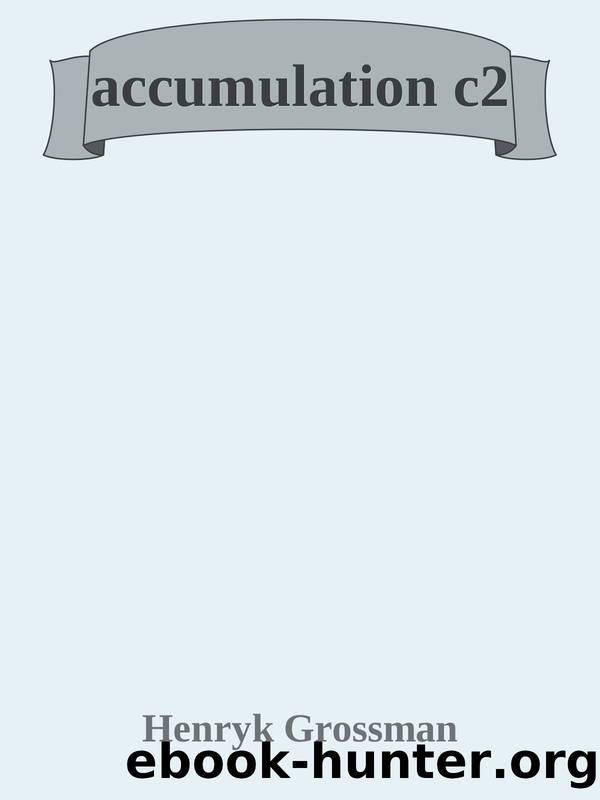Law Of The Accumulation And Breakdown by Henryk Grossman

Author:Henryk Grossman
Language: eng
Format: azw3, epub
Published: 0101-01-01T00:00:00+00:00
The elasticity of accumulation
Luxemburg criticises Marxâs scheme of expanded reproduction in the following terms: âThe limits of this expansion are each time determined in advance by the amount of surplus value which is to be capitalised in any given caseâ (1968, p. 330). She goes on to state that:
The diagram thus precludes the expansion of production by leaps and bounds. It only allows of a gradual expansion which keeps strictly in step with the formation of surplus value ... For the same reason, the diagram presumes an accumulation which affects both departments equally and therefore all branches of capitalist production. It precludes expansion of the demand by leaps and bounds just as much as it prevents a one-sided or precocious development of individual branches of capitalist production. Thus the diagram assumes a movement of the aggregate capital which flies in the face of the actual course of capitalist development. (p. 342)
This criticism has generated a whole school. A series of Marxist writers have repeated Luxemburgâs objections assuring us that Lenin was the first to formulate the law of the uneven development of capitalism. Evgeny Varga tells us that in âCapital Marx did not give a purely economic foundation to the law of the uneven development of capitalism. He took the totality of phenomena as his starting pointâ (1926, âDer uberimperialismusâ, p. 246). Apparently âLenin was the first to propose the law of uneven developmentâ (p. 248). Likewise Nikolai Bukharin refers to the âLeninist law of the unevenness of capitalist developmentâ (1926, p. 9). As always Sternberg blindly follows whatever Luxemburg has to say: âin a rigid schema of exchange under pure capitalism the sporadic development of individual industries would be inconceivableâ(1926, p. 153).
The falsehood of this view is perfectly obvious. Marx ridiculed the harmonist theory of a balanced proportional accumulation in all spheres of production. If this sort of accumulation were possible crises would not exist. This is why Marx says:
there would be no overproduction, if demand and supply corresponded to each other, if the capital were distributed in such proportions in all spheres of production, that the production of one article involved the consumption of the other, and thus its own consumption. There would be no overproduction, if there were no overproduction. Since, however, capitalist production can allow itself free rein only in certain spheres, under certain conditions, there would be no capitalist production at all if it had to develop simultaneously and evenly in all spheres. (1969, p. 532)
Luxemburgâs criticisms could only have arisen through a failure to grasp the basic aspects of Marxâs methodological procedure. Marxâs reproduction scheme represents the average line of accumulation, that is the ideal normal trajectory in which accumulation occurs proportionally in both departments. In reality there are deviations from this average line âMarx himself repeatedly draws attention to the elastic power of capital âbut these deviations are only explicable in terms of the average line. Luxemburgâs mistake is that a model that represents only the ideal trajectory in a range of possibilities is taken for an exact description of the actual trajectory of capital.
Download
Law Of The Accumulation And Breakdown by Henryk Grossman.epub
This site does not store any files on its server. We only index and link to content provided by other sites. Please contact the content providers to delete copyright contents if any and email us, we'll remove relevant links or contents immediately.
International Integration of the Brazilian Economy by Elias C. Grivoyannis(86471)
The Radium Girls by Kate Moore(11866)
Turbulence by E. J. Noyes(7894)
Nudge - Improving Decisions about Health, Wealth, and Happiness by Thaler Sunstein(7458)
The Black Swan by Nassim Nicholas Taleb(6946)
Rich Dad Poor Dad by Robert T. Kiyosaki(6316)
Pioneering Portfolio Management by David F. Swensen(6168)
Man-made Catastrophes and Risk Information Concealment by Dmitry Chernov & Didier Sornette(5877)
Zero to One by Peter Thiel(5637)
Secrecy World by Jake Bernstein(4593)
Millionaire: The Philanderer, Gambler, and Duelist Who Invented Modern Finance by Janet Gleeson(4299)
Skin in the Game by Nassim Nicholas Taleb(4122)
The Age of Surveillance Capitalism by Shoshana Zuboff(4117)
The Money Culture by Michael Lewis(4025)
Bullshit Jobs by David Graeber(3991)
Skin in the Game: Hidden Asymmetries in Daily Life by Nassim Nicholas Taleb(3867)
The Dhandho Investor by Mohnish Pabrai(3635)
The Wisdom of Finance by Mihir Desai(3605)
Blockchain Basics by Daniel Drescher(3429)
